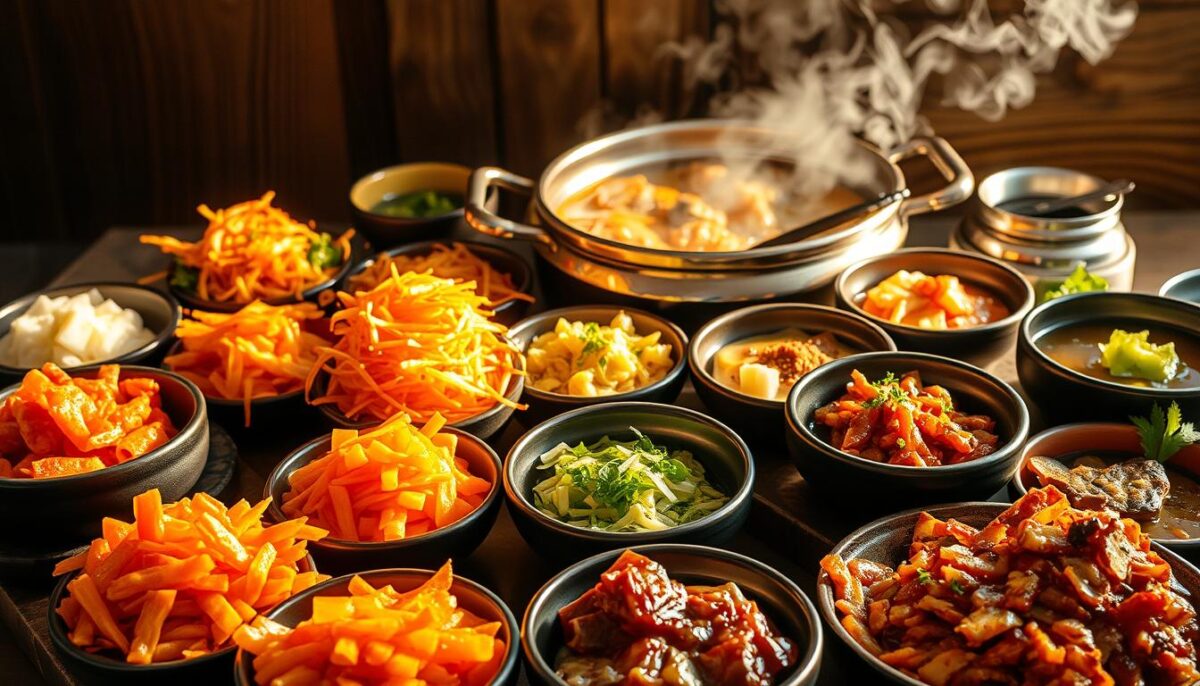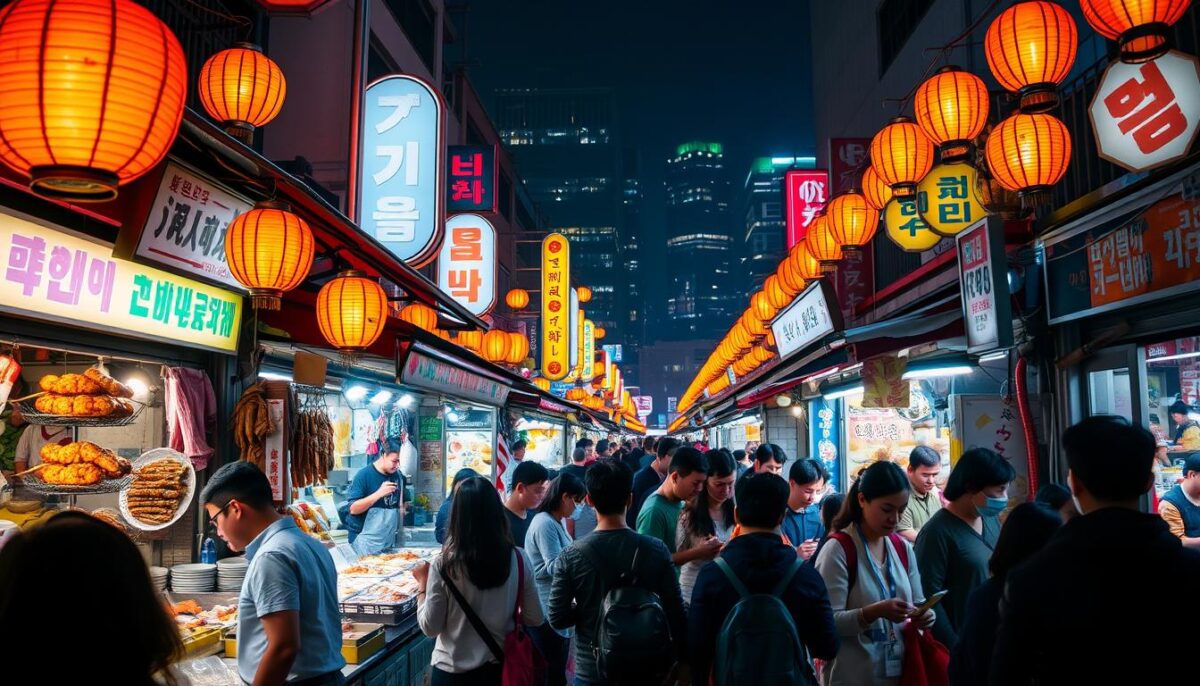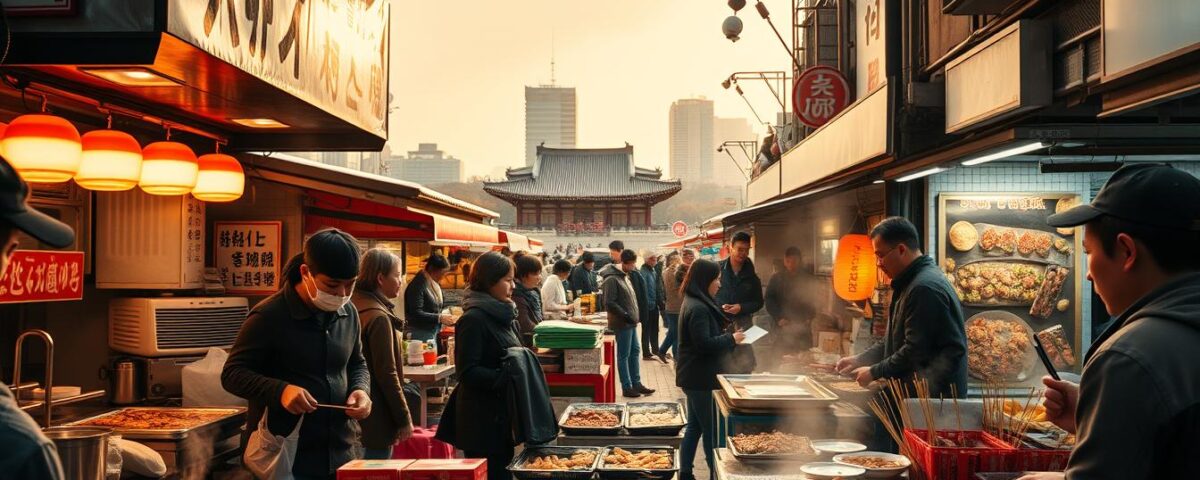
How to Eat Like a True Local in Singapore
June 7, 2025
The Ultimate Food Checklist for Your Visit to Kuala Lumpur
June 7, 2025Did you know one city sells over 2 million servings of crispy fried chicken weekly? That’s enough to fill every seat in 25 football stadiums! My first night here, I stumbled into a buzzing alley where golden-brown bites sizzled beside frosty mugs of beer. The air hummed with laughter, and I realized: this is where flavor and culture collide.
Navigating the city’s labyrinth of stalls and neon-lit markets feels like unlocking a treasure chest. From smoky barbecue joints tucked under subway lines to handheld twigim (fried snacks) that crunch like autumn leaves, every corner whispers a new secret. I still remember the thrill of biting into my first spicy rice cake, its heat balanced by sweet, chewy dough—pure magic.
What makes these flavors unforgettable isn’t just the recipes. It’s the rhythm of shared tables, the clink of soju glasses, and vendors who’ve perfected their craft for decades. Whether you’re hopping between subway stops or wandering historic districts, the city’s pulse guides you to its best-kept bites.
Key Takeaways
- Seoul’s street vendors serve over 500 unique snacks, from sweet hotteok pancakes to savory tteokbokki.
- Fried chicken paired with beer (chimaek) is a must-try cultural ritual.
- Local markets like Gwangjang offer immersive tastings of handmade dishes.
- Public transit hubs often hide underground food courts with budget-friendly meals.
- Neighborhoods like Hongdae and Myeongdong specialize in late-night culinary gems.
Introduction to Seoul’s Culinary Journey
My first encounter with the city’s cuisine felt like unwrapping a gift box—each layer revealing something unexpected. I still recall the smoky aroma of dakkochi (grilled chicken skewers) wafting from a corner cart, its sticky glaze catching the neon lights. That first bite? Sweet, spicy, and utterly transformative.
My Personal Adventure in Seoul
I quickly learned that dining here isn’t just about eating. It’s a dance between old and new. One afternoon, I savored delicate mandu dumplings at a 70-year-old stall. That evening, I tried truffle-infused bulgogi at a sleek rooftop spot. Both left me speechless.
| Venue Type | Must-Try Dish | Atmosphere | Price Range |
|---|---|---|---|
| Street Stalls | Dakkochi (Chicken Skewers) | Energetic, communal | $1-$3 |
| Upscale Restaurants | Galbi Jjim (Braised Short Ribs) | Refined, intimate | $20-$40 |
Setting the Stage for Authentic Flavors
What surprised me most? How accessible gourmet experiences are. A grandmother’s kimchi recipe holds equal weight to a Michelin-starred chef’s creation. I’ll share how to navigate this delicious duality—whether you’re hunting for the perfect fried bite or a multi-course feast.
Through trial and (happy) error, I discovered hidden gems where locals queue for hours. Their secret? Balancing tradition with bold experimentation. Let’s explore these edible adventures together.
Essential Tips for a Korean Food Experience in Seoul
Ever landed in a new city and felt overwhelmed by logistics before your culinary adventure begins? Here’s the good news: Seoul makes it easy. Many travelers qualify for visa-free entry (check your country’s requirements), and grabbing a local SIM at Incheon Airport ensures you’ll never get lost hunting for that perfect bibimbap spot.
Smart Prep = Smoother Tasting
Top priority? Get a T-money card. This rechargeable pass works on buses, subways, and even some taxis. I’ve zipped from sizzling BBQ joints in Gangnam to historic markets in Jongno using the AREX express train and Seoul Metro—both budget-friendly and faster than rideshares.
When dining, remember: rice often comes as a side dish, not the main event. Don’t be shy to ask for refills—it’s customary! For meat-based meals, sharing is standard. I once split six types of galbi (marinated ribs) with new friends at a buzzing grill house.
Research pays off. Apps like Naver Maps highlight restaurants with English menus and photos. My strategy? Bookmark three must-try dishes per neighborhood, then let spontaneity handle the rest. Pro tip: Markets like Mangwon serve smaller portions—ideal for sampling without overstuffing.
With these basics covered, you’re free to focus on what matters: those unforgettable first bites.
Navigating Seoul: From Incheon Airport to the City Center
After touchdown, I discovered how Incheon’s transport links turn travel time into tasting time. Clear signage in English guides you past baggage claim toward trains that whisk you downtown. Two main options dominate: the swift Express Train or budget-friendly Metro. Choose wisely—your first meal adventure depends on it.
Express Train vs. Seoul Metro Options
The Express Train (43 minutes, $9) offers luggage racks and plush seats—ideal for weary travelers. I once napped comfortably while zipping past suburbs. Meanwhile, the Seoul Metro (56 minutes, $4) connects to multiple lines, letting you hop off near iconic places like Hongdae’s snack alleys.
Practical Transportation Tips for Newcomers
Grab a T-money card at airport convenience stores—it works on all transit. Pro tip: Stations have elevators, but avoid rush hour if hauling suitcases. My first ride taught me to skip mid-day crowds—arriving hungry but stress-free.
Time your first meal strategically. Airport food courts serve decent kimchi jjigae (spicy soup), but I prefer saving appetite for Myeongdong’s steaming bowls. If taking the Express, you’ll reach central hubs fast enough for lunch specials at hidden places locals love.
Remember: Transportation sets the rhythm for your culinary exploration. Choose speed or savings, but always keep your chopsticks ready.
Exploring Classic Korean Dishes
Imagine a table spread with a rainbow of small plates—each bite telling a different story. My first encounter with banchan (side dishes) felt like opening a flavor encyclopedia. Crisp radish kimchi puckered my lips, while sesame-spinach whispered earthy sweetness. These aren’t just appetizers—they’re the soul of every meal.

Banchan, Kimchi, and Savory Stews
What makes these side dishes unforgettable? Variety. A single meal might feature tangy cucumber pickles, soy-braised potatoes, and that iconic fermented cabbage. I learned kimchi’s heat comes from garlic and chili sauce—a combo that’s been perfected over centuries.
Stews like doenjang jjigae showcase depth. A local chef once showed me how fermented soybean paste mingles with fresh tofu and zucchini. “The secret?” she grinned, pointing to a bubbling pot. “Letting flavors marry slowly.”
Hearty Soups and Traditional Ingredients
Winter here demands comfort in a bowl. I fell hard for seolleongtang—milky ox-bone soup simmered for days. Its richness comes from marrow, while green onions add sharp contrast. Locals often toss in rice or noodles, making it a meal itself.
Notice the artistry: vibrant yellow radish slices floating in clear broth, or ruby-red sauce drizzled over steaming dumplings. Every dish balances color, texture, and warmth—proof that tradition tastes incredible.
Korean food experience Seoul: Must-Try Main Courses
I discovered that the best meals here are those you cook yourself. Smoke rises from tabletop grills as friends lean in, tongs poised like conductors’ batons. My first galbi (marinated short ribs) sizzled into caramelized perfection while banter flowed faster than the soju.
Mastering the Grill: Meats That Sing
Thinly sliced samgyeopsal (pork belly) transforms on hot metal. Crisp edges give way to juicy centers when dipped in ssamjang paste. For beef lovers, yangnyeom galbi shines—tender ribs marinated in pear juice and soy. Pro tip: Flip meats just once for perfect char.
“Grill the garlic cloves until golden—they become sweet butter for your meat wraps.”
Flavor Harmonies Beyond the Plate
Communal dining reaches new heights here. Watch locals layer grilled meat on lettuce with pickled radish and chili threads. I learned to add a roasted garlic clove and salted shrimp for explosive umami. Pair each bite with local lager—the effervescence cuts through richness.
| Meat Type | Flavor Profile | Perfect Beer Pairing | Serving Style |
|---|---|---|---|
| Bulgogi | Sweet & Savory | Crisp Pilsner | Pre-marinated |
| Dwaeji Galbi | Spicy & Smoky | Amber Ale | Table-grilled |
| Hanu Beef | Buttery Rich | Dark Stout | Premium Cut |
Between courses, some spots serve shaved ice with sweet red beans. It’s genius—the icy sweetness resets your palate. Whether you’re sharing three dishes or ten, every meal becomes a celebration of fire, flavor, and friendship.
Street Food Adventures in Seoul
Steam rises from sidewalk carts like edible fog signals, each plume hinting at treasures below. My nostrils flared at the first whiff of gochujang-glazed dakkochi—charred chicken skewers that crackled with every turn on the grill. This is where culinary magic happens: between sizzle and savor, tradition and reinvention.
Tteokbokki, Gimbap, and Dakkochi Highlights
Let’s start with the classics. Tteokbokki isn’t just spicy rice cakes—it’s a textural symphony. Chewy cylinders swim in crimson sauce that’s equal parts sweet fire and umami depth. Nearby, gimbap rolls glisten like jeweled logs, their seaweed wrappers hugging pickled radish and sesame-spiked rice.
But the showstopper? Those dakkochi skewers. I once watched a vendor baste them with a honey-soy lacquer until they gleamed like mahogany. One bite unleashed caramelized edges giving way to juicy, garlic-kissed meat—pure street-side alchemy.
Tradition Meets Innovation
Modern stalls now riff on these icons. I tried “cheese tteokbokki” where mozzarella stretched like edible taffy between rice cakes. Fusion gimbap stuffed with bulgogi (marinated beef) surprised me—a smoky twist on the original. Even dakkochi gets upgrades, like gochugaru-rubbed versions served with tangy yogurt dip.
Yet the soul remains. As one cook told me while flipping skewers: “New ideas need old foundations.” Whether you crave handheld nostalgia or bold fusions, every dish tells a story—one best enjoyed standing shoulder-to-shoulder with locals under buzzing neon.
Iconic Restaurants and Hidden Food Gems
The real magic happens when you step off the main streets—that’s where flavors become stories. I’ll never forget squeezing into a six-seat counter near Namsan Tower, where a chef grilled deodeok roots brushed with wild honey. “Local soil grows best ingredients,” he said, serving mountain herbs picked that morning.
Local Recommendations From My Travels
Communal tables turn strangers into friends. At a tucked-away spot in Insadong, I shared sanchae bibimbap with artists discussing brush techniques. The dish? A rainbow of seasonal vegetables atop nutty rice—each bite crisp and vibrant.
| Venue Type | Signature Dish | Wait Time | Atmosphere |
|---|---|---|---|
| Neighborhood Eatery | Kimchi Jjigae | 10-15 mins | Cozy, family-run |
| Hidden Gem | Burdock Root Salad | 30+ mins | Intimate, chef’s counter |
| Trendy Hotspot | Truffle Japchae | 20-25 mins | Lively, modern |
Dining Scenes in Myeongdong and Hongdae
Myeongdong’s neon-lit lanes hide basement joints serving naengmyeon (chilled noodles) since the 1980s. For quicker travel between bites, visit before 6 PM—lines triple by dusk. Hongdae’s artsy cafes reinvent classics: think vegetable-stuffed dumplings with edible flower garnishes.
Pro tip: Watch where locals queue. A 45-minute wait at a Myeongdong table grill spot rewarded me with melt-in-mouth short ribs. As one regular told me: “Good time investment tastes better.”
Experience Korean Comfort Foods and Soups
There’s a particular alchemy in dishes that heal as they nourish. On a drizzly afternoon near Namsan Mountain, I found myself cradling an earthenware pot of samgyetang—a whole chicken simmered with ginseng and jujubes. The steam carried whispers of centuries-old recipes perfected for both body and soul.
Bowlfuls of History and Warmth
Samgyetang’s magic lies in its simplicity. The broth—golden and aromatic—seeps into every crevice of tender poultry. A local chef once told me: “We eat this in summer’s heat to balance our energy.” Contrast this with sundubu jjigae’s fiery red bubbles, where silken tofu melts alongside briny clams. Both dishes showcase how tradition thrives in the city’s modern kitchens.
Broths That Tell Stories
What makes these stews unforgettable? Time. I watched cooks simmer pork bones for galbitang (short rib soup) until the marrow surrendered its richness. In doenjang jjigae, fermented soybean paste mingles with diced zucchini and—often—generous chunks of pork belly. The result? Depth that instant noodles could never replicate.
- Galbitang: 12-hour bone broth with fall-off-the-bone ribs
- Kimchi jjigae: Aged cabbage adds tang to spicy pork base
- Seolleongtang: Milky ox-bone soup served with spring onions
Dining the way locals do means pairing stews with bbq-style banchan. Crisp perilla leaves and garlicky bean sprouts cut through rich broths beautifully. Whether you’re recovering from jet lag or braving urban winters, these bowls offer more than warmth—they’re edible hugs from generations past.
Decadent Korean Desserts and Drinks
I found dessert paradise under a striped awning near Bukchon Village, where steam from red bean paste met frosty clouds of shaved ice. This sweet counterpoint to smoky barbecue flavors reveals how ingredients transform into edible art—one delicate spoonful at a time.
Indulging in Patbingsu and Local Sweets
Modern patbingsu resembles a snow-capped mountain range. Chefs layer feather-light ice with sweetened azuki beans, chewy rice cakes, and fresh fruit. I once discovered a version topped with roasted soybean powder—its nutty depth balancing condensed milk drizzle perfectly.
Street vendors offer quick delights too. Hotteok pancakes ooze cinnamon-brown sugar filling, while walnut-shaped hodugwaja cakes hide sweet bean centers. These portable treats fuel afternoon explorations between lunch stops.
Refreshing Korean Beverages and Banana Milk
Nothing caps a spicy meal like icy banana milk. Its creamy sweetness became my ritual after kimchi-heavy lunches. Local cafes also craft persimmon smoothies and roasted barley tea—perfect for recharging during long sightseeing days.
For something stronger, try sikhye (sweet rice drink). I still remember my first sip at a Namdaemun Market stall—its subtle malt flavor cutting through summer heat like liquid gold.
Pro tip: Save elaborate desserts for post-dinner strolls. Hidden gelato shops near Han River blend green tea with black sesame—a fusion that tastes like my best trip discoveries rolled into one cone.
Outdoors and Night Food Markets in Seoul
Twilight transforms the city into a carnival of flavors, where neon signs hum like fireflies above sizzling griddles. I once followed a trail of laughter to a bustling alley near the Han River—its air thick with caramelized garlic and the crackle of hot oil. This is where night becomes a verb, and every corner pulses with edible energy.

Exploring vibrant night stalls and markets
Rows of stalls become culinary theaters after dark. At one, I watched a vendor drizzle honey over flower-shaped cakes still bubbling from the press. Nearby, squid tentacles curled dramatically on a grill, their edges charring to perfection. The rhythm here feels contagious—a lot of chatter, sizzle, and shared grins between strangers.
What surprised me? The artistry in simple dishes. Crispy cakes filled with molten cheese sat beside towers of fruit-topped shaved ice. One stall specialized in paper-thin crepes rolled around fresh cream and matcha powder. “We use recipes from my grandmother’s village,” the cook explained, flipping batter with practiced flicks.
“Come hungry, leave with stories. That’s our market rule.”
These spaces reveal local culture through taste. Families cluster around shared plates of twigim (fried veggies), while students debate over spicy rice cakes. I learned to follow the lines—a lot of locals waiting means guaranteed freshness. Pro tip: Arrive early for crispy seafood pancakes, or late for discounted cakes as vendors pack up.
Between bites, I marveled at how these stalls create community. Strangers become friends over steaming bowls, and every purchase supports generations-old recipes. It’s more than snacking—it’s tasting the heartbeat of the city after dark.
Tips for Making the Most of Your Culinary Trip
Your spoon hovers over a steaming bowl—do you dive in now or wait for the perfect moment? Timing and strategy turn good meals into unforgettable journeys. I’ve learned when to chase midday specials and when to linger for night market treasures.
Sync Your Bites With the City’s Rhythm
Arrive early for broths simmered since dawn. Many places restock ingredients once—miss the lunch rush, and you’ll get weaker batches. I once visited a famed broth spot at 3 PM only to find it sold out. Now I plan times like a local: hearty stews at noon, lighter bites by dusk.
| Meal Period | Best Dishes | Wait Times | Pro Tip |
|---|---|---|---|
| 7-9 AM | Gukbap (Soup Rice) | 5-10 mins | Follow office workers |
| 12-2 PM | Galbitang (Rib Soup) | 15-25 mins | Share tables to skip lines |
| 6-8 PM | Hand-cut Noodles | 20-30 mins | Bookmark via Naver Maps |
Tech Meets Taste Buds
Apps like MangoPlate spotlight hidden gems with photo menus. I found a 10-seat broth haven using filters for “locals-only” spots. Offline, ask servers where they eat—their go-to bowl joints often outshine tourist traps.
Stay flexible. A sudden downpour once rerouted me to a basement mandu spot—their kimchi dumplings became my trip’s highlight. Pack comfortable shoes and curiosity: the best times happen when plans bend.
Conclusion
Every bite in this city feels like a handshake between generations—sauces simmered for decades, recipes whispered from grandparents’ kitchens. Through alleyway carts and sizzling markets, I learned flavors here aren’t just tasted—they’re lived.
Remember the thrill of your first gochujang-glazed skewer? Or that broth that warmed you like a local’s smile? These moments stitch together a mosaic of culinary wisdom. Whether you’re drizzling sesame oil over midnight noodles or swapping stories with locals at shared tables, each dish becomes a passport to deeper connections.
Don’t just follow maps—follow curiosity. Let fermented soybean paste surprise you. Ask about the chili blend in that crimson sauce. Behind every sizzling grill, there’s a chef eager to share their craft.
My journey taught me this: tasting is learning. Every market stall and steam-filled tent holds chapters of history waiting to be savored. Now it’s your turn—what stories will your chopsticks uncover?
FAQ
What’s the best way to handle transportation from Incheon Airport?
I always recommend the AREX Express Train for speed, but the Seoul Metro is cheaper. Grab a T-money card at convenience stores for seamless rides on buses and trains.
Which street food stalls should I prioritize?
Don’t skip Myeongdong Night Market—their tteokbokki (spicy rice cakes) and dakkochi (chicken skewers) are legendary. For a modern twist, try Hongdae’s cheese-filled gimbap.
How do I navigate local dining etiquette?
Use both hands when passing dishes, and wait for elders to eat first. At BBQ spots, grill meat with ssamjang (fermented sauce) and lettuce wraps. Tipping isn’t common here!
What’s a must-try comfort dish during colder months?
Warm up with samgyetang (ginseng chicken soup) or sundubu jjigae (spicy tofu stew). Pair it with kimchi and steamed rice for that authentic touch.
Where can I find the best desserts?
Head to Sulbing for fluffy patbingsu (shaved ice) topped with red bean. For nostalgia, grab a cold banana milk from any convenience store—it’s a childhood favorite!
Are there vegetarian-friendly options?
Yes! Look for bibimbap without meat, or naengmyeon (cold buckwheat noodles). Many banchan (side dishes) are plant-based, but confirm with staff about broth ingredients.
What’s the ideal time to visit night markets?
Arrive around 6 PM to beat crowds but still catch fresh snacks. Markets like Gwangjang stay lively until midnight—perfect for late-night hotteok (sweet pancakes).
How do I avoid tourist traps in popular areas?
Follow locals! If a spot has a line of residents, it’s worth the wait. Apps like Naver Map highlight hidden gems beyond Itaewon or Gangnam.



